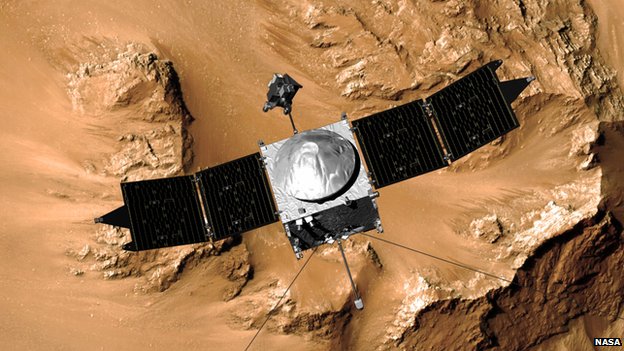Until 3 billion years ago, Mars was a wet planet much like Earth. It had land, an extensive atmosphere and an ocean that covered two thirds of the northern hemisphere as well as smaller bodies of water. But significant climate change caused the water and atmosphere to boil away, leaving Mars a dry and arid planet. Or so we thought… then came the news from Nasa – Water found on Mars!
A Trip to Mars!
Imagine being able to catch a flight to Mars as easily as we travel to another country – that was the idea behind the Trip To Mars session I attended at the Cheltenham Science Festival. It was conducted by Dr Suze Kundu and Dr Simon Foster and presented as a pre-flight safety briefing, with both of them dressed as pilots! There were a lot of humorous moments and sci-fi references but also some great science.
Suze and Simon suggested that in the future, flights to Mars could be far quicker than they are now, and explored how some of the bigger problems could be overcome. For example, the Sun’s magnetic field deflects a significant proportion of the cosmic radiation that could be harmful to humans on Earth; as spaceships travel further away from the Earth and Sun they will have less protection because the magnetic field weakens. To combat this it’s possible that spaceships will contain or be covered with large and powerful magnets, to produce the same deflective effect. This would have the added advantage of also deflecting radiation from solar flares.
Spaceships journeying to Mars would travel at such speed that even tiny fragments of rock and dust could be damaging to the hull. To combat this, and also the heat generated when the spaceship passes through an atmosphere, Suze and Simon discussed the possibility of spaceships being coated in aerogel. This amazing material is a solid formed from silicone dioxide but is 98% air; this means that it is extremely light but also strong. Its melting point is 1,200°C (equivalent to asbestos) and it is a wonderful insulator. Because it consists of large pockets of air between thin layers of silicone dioxide, any dust or rock fragments that hit it would be slowed and stopped before they could penetrate the aerogel completely.
Suze and Simon also discussed the possibilities and problems with cryostasis. Theoretically this is when a person’s body is cooled to temperatures so low that they enter hibernation, ideal for long journeys through space. Unfortunately our technology isn’t advanced enough to do this at the moment; any attempt would result in the cells rupturing and the person dying. But in the future it will be possible, perhaps after the person’s DNA has been altered slightly so that they can produce antifreeze proteins like some species of wasps and turtles.
The Discovery of Beagle 2
There’s been a lot of excitement in the scientific community recently, with the announcement of the discovery of Beagle 2. But what is it and how did it get lost? (And no, it has nothing to do with dogs!)
What is Beagle 2?
Beagle 2 is a landing spacecraft just 2 metres across that was built by a team of British scientists, led by Professor Colin Pillinger. It was designed to examine the surface of Mars, measuring the different amounts of carbon and other chemicals in an attempt to determine whether life could have existed on the planet at some point in time.
Why is it called Beagle 2?
The spacecraft was named after HMS Beagle, the ship that carried Charles Darwin on his voyage around Earth in the 1830s. This voyage led to a much greater understanding of life on our planet; Professor Pillinger and his team hoped that Beagle 2 would do the same for our knowledge of any life on Mars.
How was Beagle 2 lost?
On the 19th December 2003 Beagle 2 was launched from the Mars Express orbiter, and on the 25th December it descended towards the surface of Mars. Once it had landed safely it was programmed to deploy its solar panels and contact Mars Express. Unfortunately it was never heard from again, and was declared lost on the 6th February 2004.
How was it found?
A NASA spacecraft, the Mars Reconnaissance Orbiter, is currently orbiting the red planet and photographing its surface. After searching through billions of pixels in large quantities of images, the Beagle team believe that they have found their craft.
Although more focused photographs need to be taken in order to determine exactly how Beagle 2 is lying, it looks as though the lander made it to the surface safely but only deployed 2 or maybe 3 of its 4 solar panels. The radio antennae with which it should have contacted Mars Express is tucked underneath the fourth panel, and so was never able to function. The Beagle 2 team are overjoyed to have found their lost lander, although Professor Colin Pillinger died in May 2014 without ever knowing what had happened to his craft.
Now what?
Hopefully future images from the Mars Reconnaissance Orbiter will show even more clearly how Beagle 2 is positioned. The lander was partly battery powered and would have been able to record images and data as it descended through the atmosphere, but this information is locked inside its memory and inaccessible. Andrew Coates, who was the lead investigator on Beagle 2’s stereo camera system, has said that it’s likely that the images and data exist and joked that “All we need is an astronaut and a USB stick to go and get them!”.








